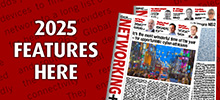04 November 2024

Fred Whipp, VP of business development, mpro5
Many industries are turning to the Internet of Things (IoT) for real-time monitoring, data-driven decision-making and streamlined automation. With the market predicted to soar from US$714.48 billion in 2024 to a staggering US$4,062.34 billion by 2032, achieving a compound annual growth rate (CAGR) of 24.3%, the potential for digital transformation is immense. However, to exploit this potential effectively, organisations must learn how to bypass a series of common pitfalls during IoT implementation and maintenance.
The IoT market is expanding rapidly - its growth underpinned by the increasing reliance on data for strategic decision-making. IoT solutions enable more efficient management of facilities as they offer significant advantages such as increased automation, real-time monitoring and enhanced data collection. This trend is evident in the UK, where Eseye’s 2023 study found that 79% of respondents plan to ramp up their IoT deployments. Yet, successful integration begins with identifying the specific IoT use cases relevant to each enterprise.
“IoT solutions enable more efficient management of facilities as they offer significant advantages such as increased automation, real-time monitoring and enhanced data collection.”
Identifying IoT use cases
Before organisations deploy IoT technology, they should first identify specific parts of their operations that are particularly vulnerable to problems or disruptions. These are areas where quick responses are crucial to maintaining smooth operations. Additionally, organisations should identify the functions that are essential for their overall business performance. These are the tasks or processes that, if disrupted, would have a significant negative impact on the business. Setting clear goals for how IoT will be used in these areas is vital. These goals should define what the organisation aims to achieve with IoT implementation and how it will improve the experience for customers.
Research by Beecham highlights that one of the most common reasons for IoT project failures among 25,000 respondents is the absence of clearly defined business objectives. Organisations need to establish precise IoT goals to guide the deployment and ensure it aligns with their broader business strategies. This level of transparency enhances the likelihood of successful implementation while also maximising the positive impact on customer experiences.
Common implementation pitfalls
A frequent issue in IoT deployment is the misapplication of cameras and sensors. Organisations often install these devices without specific goals in mind or use them retrospectively to address issues rather than proactively for prevention. Forward-thinking is therefore required to utilise IoT systems effectively, which positions them in preventative roles where they can capitalise on important features such as real-time feedback.
Another significant pitfall is the mismanagement of triggering actions. Some organisations record data without triggering appropriate actions, while others overuse alerts, leading to alert fatigue where real issues are overlooked. This results in a passive approach to data use, with either a lack of action triggers or an overabundance, both leading to an ineffective priority matrix.
Optimising IoT investment
IoT applications can vary widely across industries. In catering, retail, and facilities management, for example, sensor-driven maintenance can trigger workflows in response to irregularities, such as temperature fluctuations, thereby alerting staff promptly and reducing response times. Understanding and planning for effective IoT use cases before implementation significantly increases the chances of project success.
The cost of installing IoT cameras, sensors, and the necessary network infrastructure is substantial. To optimise IoT expenditure and maximise return on investment, businesses can turn to three fundamental rules: Alert, Action, and Resolution. Firstly, define the conditions for triggering alerts. Secondly, specify the actions to be taken once alerts are triggered. Finally, outline the process for recording and resolving issues. This structured approach helps to avoid overcomplication and ensures that IoT systems genuinely enhance business operations.
Enterprises embracing IoT
Enterprises across various sectors are utilising IoT technologies to enhance their business operations. This includes retailers where IoT integration has offered unprecedented opportunities to optimise operations, improve safety, and drive sustainable growth. Examples include dynamic cleaning with IoT sensors revolutionising traditional cleaning practices in stores by identifying high-traffic areas during peak hours while scheduling deeper cleanings for quieter periods.
Retailers are also embracing IoT technology for crowd control with IoT sensors monitoring the number of customers entering and exiting the store in real-time, enabling store managers to adjust staffing levels and manage queues efficiently during peak hours, proactively preventing overcrowding and optimising space usage. IoT cameras also serve as a proactive safety measure, detecting spillages and other hazards in real time, enabling timely interventions, and reducing the risk of accidents, liabilities, and associated costs.
Other sectors embracing IoT in the UK include the contract catering sector. Impactful IoT technologies, such as barcode scanners, temperature probes and RFID infrared readers, are being utilised before produce reaches caterers, tracking changes in temperature and moisture, impacting food quality across supply chains.
Food service enterprises are also using IoT technologies to improve food safety. Operators are moving away from manual paper-based processes and are investing in IoT sensors that regularly monitor the status and temperature of refrigeration equipment. Such devices send automated real-time alerts to catering managers’ devices, whether on-site or not, allowing them to resolve fridge temperature emergencies and avoid food spoilage.
Lastly, IoT sensors are utilised by catering enterprises to detect when a fridge or freezer goes above certain temperatures - alerting members of staff before the problem worsens, saving businesses thousands a year.
Conclusion
It goes without saying that avoiding common pitfalls in IoT implementation is crucial for achieving the full benefits of this transformative technology. A well-defined IoT framework, clear business objectives and a proactive approach to data use are essential components of successful deployment. While the IoT market continues to grow, organisations that understand and overcome these complexities effectively will be well-positioned to drive digital transformation and gain a competitive edge.










